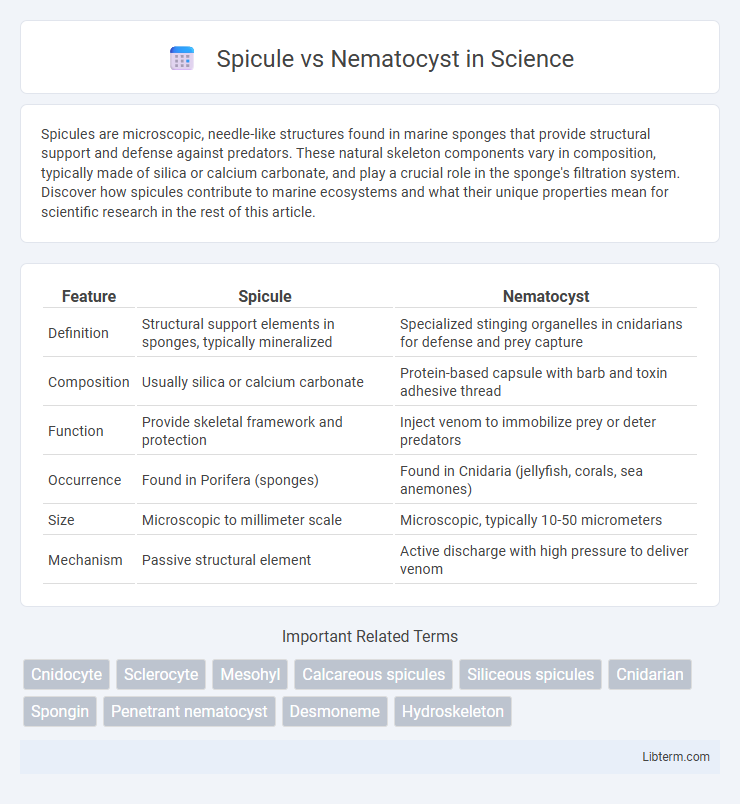Spicules are microscopic, needle-like structures found in marine sponges that provide structural support and defense against predators. These natural skeleton components vary in composition, typically made of silica or calcium carbonate, and play a crucial role in the sponge's filtration system. Discover how spicules contribute to marine ecosystems and what their unique properties mean for scientific research in the rest of this article.
Table of Comparison
| Feature | Spicule | Nematocyst |
|---|---|---|
| Definition | Structural support elements in sponges, typically mineralized | Specialized stinging organelles in cnidarians for defense and prey capture |
| Composition | Usually silica or calcium carbonate | Protein-based capsule with barb and toxin adhesive thread |
| Function | Provide skeletal framework and protection | Inject venom to immobilize prey or deter predators |
| Occurrence | Found in Porifera (sponges) | Found in Cnidaria (jellyfish, corals, sea anemones) |
| Size | Microscopic to millimeter scale | Microscopic, typically 10-50 micrometers |
| Mechanism | Passive structural element | Active discharge with high pressure to deliver venom |
Introduction to Spicules and Nematocysts
Spicules are structural elements found in sponges, composed primarily of silica or calcium carbonate, providing support and defense. Nematocysts are specialized stinging cells unique to cnidarians, containing venomous barbs used for prey capture and protection. Both serve crucial roles in the survival of these aquatic invertebrates but differ significantly in function and composition.
Defining Spicules: Structure and Function
Spicules are microscopic structural elements found primarily in sponges, composed of silica or calcium carbonate, providing essential support and defense. These needle-like formations vary in size and shape, contributing to the sponge's skeletal framework and deterring predators through their rigid, sometimes sharp, morphology. Unlike nematocysts, which are specialized stinging cells in cnidarians used for prey capture and defense, spicules serve predominantly mechanical roles without involvement in venom delivery.
Understanding Nematocysts: Anatomy and Purpose
Nematocysts are specialized organelles found within cnidocytes of jellyfish, sea anemones, and other cnidarians, functioning primarily as defensive and prey-capturing mechanisms. Their anatomy includes a coiled, harpoon-like filament that rapidly everts to inject toxins into targets, aiding in immobilization and protection. Unlike spicules, which are structural support elements in sponges, nematocysts are dynamic cellular components essential for survival in predatory and defensive behaviors.
Taxonomic Distribution: Where Are Spicules and Nematocysts Found?
Spicules are rigid skeletal elements found primarily in Porifera, especially within classes Demospongiae and Calcarea, providing structural support to sponges. Nematocysts are specialized stinging organelles characteristic of Cnidaria, including classes Anthozoa, Scyphozoa, and Hydrozoa, used for prey capture and defense. These distinct taxonomic distributions highlight spicules as key identifiers in sponges and nematocysts as unique to cnidarian species.
Structural Differences: Spicules vs Nematocysts
Spicules and nematocysts differ fundamentally in structure and function; spicules are rigid, mineralized skeletal elements primarily composed of silica or calcium carbonate, providing structural support to sponges. Nematocysts are specialized, capsule-like organelles found in cnidarians, containing a coiled, barbed thread that can rapidly evert to deliver toxins for prey capture or defense. While spicules serve as passive structural components forming the sponge's framework, nematocysts are active cellular mechanisms crucial for cnidarian survival and interaction.
Biological Roles in Marine Organisms
Spicules provide structural support and defense against predators in sponges by forming a rigid skeleton of silica or calcium carbonate, enhancing their survival in marine ecosystems. Nematocysts, specialized stinging cells found in cnidarians like jellyfish and anemones, serve primarily for prey capture and protection through rapid toxin injection. These distinct biological roles illustrate the adaptation of spicules and nematocysts to support defense and feeding mechanisms critical to the ecological success of marine organisms.
Mechanisms of Action: How They Work
Spicules function primarily as structural elements in sponges, composed of silica or calcium carbonate, providing physical support and deterring predators through their sharp, needle-like shape. Nematocysts, found in cnidarians such as jellyfish and corals, operate through a rapid explosive mechanism that ejects a harpoon-like thread coated with toxins to capture prey or defend against threats. The discharge of nematocysts is triggered by chemical and mechanical stimuli, causing high osmotic pressure to forcefully project the thread, whereas spicules lack active defense functionality but serve as passive protection via their rigid framework.
Evolutionary Significance and Adaptation
Spicules and nematocysts represent distinct evolutionary adaptations that enhance survival in aquatic environments. Spicules, primarily found in sponges, provide structural support and deter predators through their rigid, often silica-based composition. Nematocysts, characteristic of cnidarians, function as specialized, stinging organelles that deliver venom to capture prey and defend against threats, highlighting a complex evolutionary advancement in predation and protection mechanisms.
Ecological Impact and Defensive Mechanisms
Spicules and nematocysts serve distinct ecological roles in aquatic environments, with spicules providing structural support and deterring predators in sponges, while nematocysts deliver venomous stings for defense and prey capture in cnidarians. The ecological impact of spicules includes contributing to habitat complexity and sediment composition, whereas nematocysts influence predator-prey interactions and community dynamics through their potent defensive and offensive capabilities. Both adaptations enhance survival but operate through different mechanisms: spicules rely on mechanical deterrence, and nematocysts utilize biochemical toxin delivery.
Summary Table: Key Differences Between Spicules and Nematocysts
Spicules are structural elements primarily found in sponges, composed of silica or calcium carbonate, providing support and defense, while nematocysts are specialized stinging organelles located in cnidarians such as jellyfish and sea anemones, used for prey capture and defense. Spicules vary in shape and size, contributing to sponge taxonomy, whereas nematocysts contain harpoon-like structures that discharge toxins upon stimulation. The key differences include their biological function--spicules offer mechanical protection, nematocysts function in predation--and their composition, with spicules made of mineralized materials versus the proteinaceous capsules of nematocysts.
Spicule Infographic

 libterm.com
libterm.com